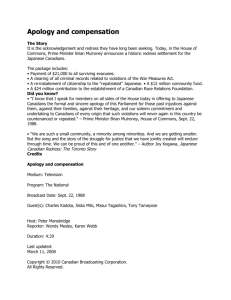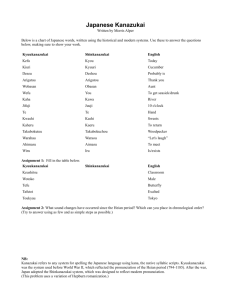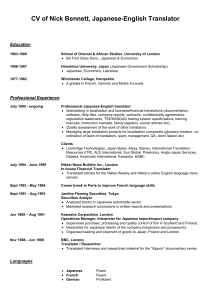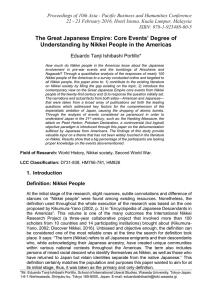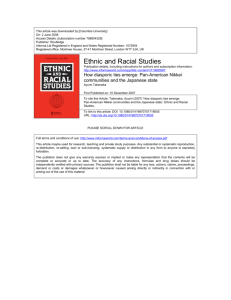Kobayashi story telling
advertisement
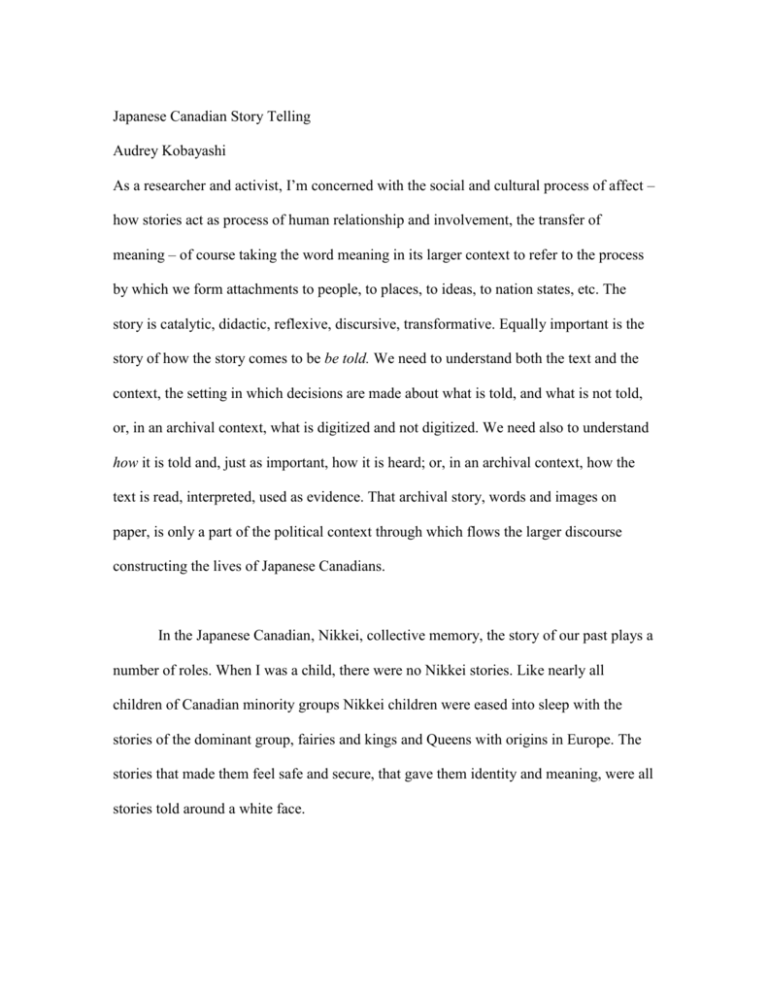
Japanese Canadian Story Telling Audrey Kobayashi As a researcher and activist, I’m concerned with the social and cultural process of affect – how stories act as process of human relationship and involvement, the transfer of meaning – of course taking the word meaning in its larger context to refer to the process by which we form attachments to people, to places, to ideas, to nation states, etc. The story is catalytic, didactic, reflexive, discursive, transformative. Equally important is the story of how the story comes to be be told. We need to understand both the text and the context, the setting in which decisions are made about what is told, and what is not told, or, in an archival context, what is digitized and not digitized. We need also to understand how it is told and, just as important, how it is heard; or, in an archival context, how the text is read, interpreted, used as evidence. That archival story, words and images on paper, is only a part of the political context through which flows the larger discourse constructing the lives of Japanese Canadians. In the Japanese Canadian, Nikkei, collective memory, the story of our past plays a number of roles. When I was a child, there were no Nikkei stories. Like nearly all children of Canadian minority groups Nikkei children were eased into sleep with the stories of the dominant group, fairies and kings and Queens with origins in Europe. The stories that made them feel safe and secure, that gave them identity and meaning, were all stories told around a white face. Another kind of story that most children hear are the stories that give meaning to family, stories of family heritage, how mum met dad, how we came to be – here, in this place. But one big difference for most of the postwar generation of Nikkei children was a gaping hole in their collective past. I had an English grandmother and Japanese grandmother. My English grandmother always told me stories. I know many of the details of her life prior to emigration. My Japanese grandmother gave me no stories, only kindness. The first generation, the Issei, seldom told their stories, partly because a language barrier, partly because a cultural practice of stoic dismembering of past and present upon emigration. To re-member the past was, for most of the Issei, a painful thing, made more painful by the events of the 1940s. The term “ganbare” – to endure – which became the slogan of that time of exile, extended to storytelling. One does not reveal one’s pain. For the second generation, the Nisei, the events of the 1940s were not only physically traumatic, as they were uprooted from homes, schools, friends and banished to remote parts of the country. The experience was also a form of identity theft, their identity as Canadians stripped away, the capacity to remember thereafter stifled by the development of a capacity to forget. The Nisei are as a result in so many ways the forgotten generation, forgotten above all by themselves. So, it is not surprising that the period of the 1940s was seldom spoken of, especially in front of children. The third generation, the sansei, were mostly conceived in the period shortly after the measures taken under the War Measures Act were ended in 1949. They were part of the baby boom, but emerged with a gaping hole in their past, a time dismembered, representing a loss of something that they had never had. If the Nikkei past was one in which stories were suppressed, stories nonetheless played an important part in the healing that took place leading up to and after the Redress settlement of 1988. Some of the stories were public. In 1971, Shizuye Takashima wrote a children’s book, A Child in Prison Camp, a beautifully illustrated and emotionally evocative story of a young girl in camp. Not exactly bedtime reading, but the first account in English that received wide public distribution. Of course it was Joy Kogawa’s Obasan that became the most famous and widely acclaimed Nikkei story. Published in 14 languages, Obasan has perhaps done more than any other book to tell convey the Nikkei experience to the world. Not only does Obasan tell the story, but it legitimizes the Nikkei experience. The act of writing, of accounting, for that experience gives it reality, gives it an empirical presence. (and I note that the words empirical and experience have the same etymology.) So at the same time that the broader world began to acknowledge and understand Nikkei experience, Nikkei began to acknowledge, and thus also to understand, themselves. Story telling has a more complex role. Leading up to the redress settlement of 1988 required a diachronic process of convincing the government and the general public of the rightness of our cause, and at the same time initiating the healing within the community that would encourage all Nikkei to come out and fight. In that process, stories of the past were told and re-told, and in the process the narrative shifted from recollections of sorrow and suffering to political conviction and a sense of human rights. This discursive act of remaking our history set the tone for what was to be a new Canadian story, that of a redress settlement that both changed Japanese Canadian history and struck a new tone for Canadian history in general. Note: The historical story of Japanese Canadians has a rich archival history. Partly because of the injustices of the past, including both severe immigration restrictions and the actions against Japanese Canadians during the 1940s, the archives contain information that does not exist for other ethnic groups. This information includes detailed information on those who immigrated under the terms of the “Gentlemen’s Agreement” between 1907 and World War I, and information on who was where during the period of uprooting in the 1940s. I have combined these records with detailed records kept by the Japanese government, with taxation and street directory records in Vancouver, with detailed records and stories collected (in Japanese) of the original Nikkei community on Powell Street in Vancouver, and with a variety of records of community groups, to create an interactive data base that can be searched by individual family name or by geographic location. Putting these records together in a relational data base allows the researcher to compile both personal histories, and histories of specific addresses inhabited by Japanese Canadians in pre-World War II British Columbia. References Goto, Hiromi 1994. Chorus of Mushrooms. Edmonton: New West Press. Ito, Sally 1998. Floating Shore. Toronto: Mercury Press Nakano, Takeo Ujo and Leatrice Nakano 1980. Within the Barbed Wire Fence: A Japanese Man’s Account of His Internment in Canada. Kiyooka, Roy. 1997. Mothertalk: LifeStories of Mary Kiyoshi Kiyooka. Edmonton: New West Press. Kobayashi, Audrey 1995. “Birds of passage or squawking ducks: Writing across generations of Japanese-Canadian Literature.” In Writing Across Two Worlds: Literature and Migration, eds RussellKing, John Connell, and Paul White, 216228. London: Routledge. Kogawa, Joy 1981. Obasan. Toronto: Lester and Orpen Dennys. Miki,Roy Broken 1998. Entries: Race Writing Subjectivity. Toronto: Mercury Press. Morita, Katsuyoshi. 1988. Powell Street Monogatori. Burnaby BC: Live Canada Publishing. Nakagawa, Roy K. Ocean Falls Recollections: Story of the Town Where I was Born. Toronto: Roy K. Nakagawa. Omatsu, Maryka. 1992. Bittersweet Passage: Redress and the Japanese Canadian Experience. Toronto: Between the Lines. Sakamoto, Kerri 1998. The Electrical Field. Toronto: Fred A. Knopf. Watada, Terry. 1997. Daruma Days A Collection of Fictionalized Biography. Vancouver: Ronsdale Press. .
